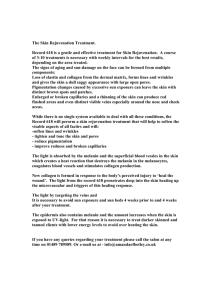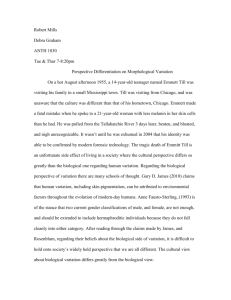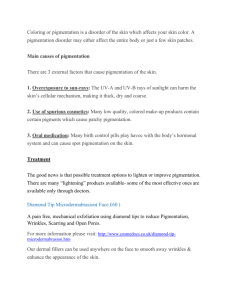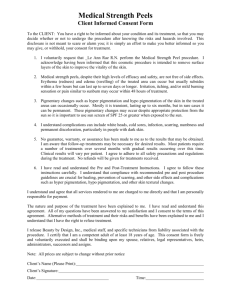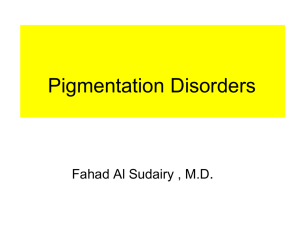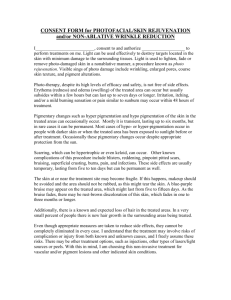Pigmented Lesions I
advertisement
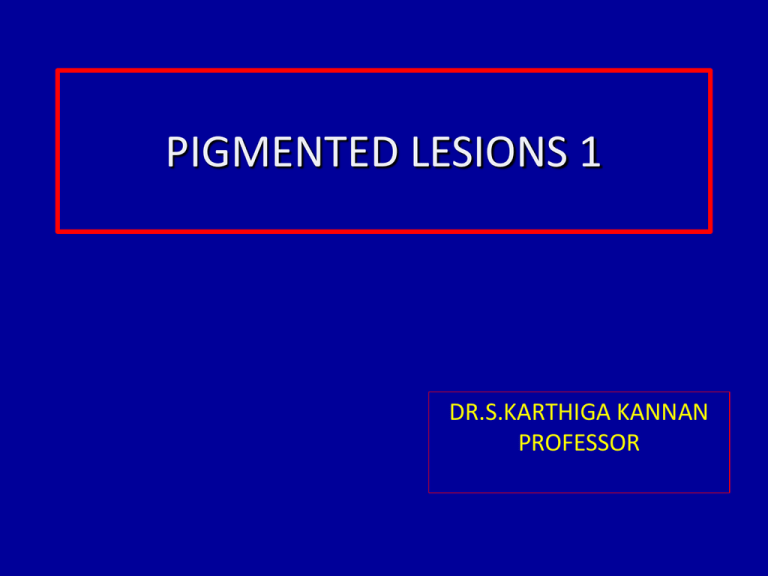
PIGMENTED LESIONS 1 DR.S.KARTHIGA KANNAN PROFESSOR SPECIFIC LEARNING OBJECTIVES TO KNOW ABOUT PIGMENTS AND PIGMENTED LESIONS TO RECOGNISE THE CLINICAL FEATURES OF PIGMENTED LESIONS TO KNOW THE INVESTIGATION AND MANAGEMENT OF THESE LESIONS FORMAT 1. INTRODUCTION OF PIGMENTS 2. CLASSIFICATION OF PIGMENTS 3. FUNCTIONS OF PIGMENTS 4. CLASSIFICATION OF DISEASES PRODUCING ENDOGENOUS PIGMENTATION 5. PHSIOLOGY OF MELANIN SYNTHESIS 6. BROWN BLACK MELANIN DERIVED PIGMENTATION PIGMENTS Pigments are colored substance present in most living beings CLASSIFICATION PIGMENTS ENDOGENOUS PIGMENTS EXOGENOUS PIGMENTS Melanin Hemoglobin Hemosiderin Bilirubin Amalgam tattoo Graphite tattoo Heavy metals poisoning Chromogenic bacteria Medicines Food stuff Carotene Porphyrin FUNCTIONS OF PIGMENTS MELANIN : To protect from UV radiation, antioxidant CAROTENE : Active component of Vitamin A, antioxidant HEMOGLOBIN: Carries Oxygen & Carbon dioxide BILIRUBIN : Physiological by-products of hemoglobin HEMOSIDERIN: Physiological by-products of hemoglobin PORPHYRIN : Physiological by-products of hemoglobin MELANIN Brown black non haemoglobin derived protien Normally present in the skin, hair, choroid of the eye ,meninges and adrenal medulla Synthesized in the melanocytes. Stored in the form of cytoplasmic granules in melanophores PHYSIOLOGY OF MELANIN SYNTHESIS Tyrosinase Tyrosine Melanin In melanocytes MELANOCYTE BROWN BLACK MELANIN DERIVED PIGMENTATION Increased melanin synthesis (Basilar melanosis) Increased melanocytes 1.Physiologic / Racial 1.Nevus 2.Malignant melanoma 2.Malanotic macule or Ephelis 3.Post inflammatory pigmentation 4.Smokers melanosis 5.Drug induced melanosis 6.Lichenplanus 7.Peutz jegher syndrome 8.Melasma/cholasma 9.Café au lait pigmentation 10.Adisson’s disease 11.HIV melanosis PHSIOLOGIC PIGMENTATION ETIOLOGY AND PATHOGENESIS Melanin production and deposition is often a physiologic process, more especially in dark skinned individuals. CLINICAL FEATURES Site - Gingiva are the most frequent site. The pigmentation can vary from brown to black and may be symmetrical or asymmetrical DIAGNOSIS Diagnosis by clinical presentation and history but biopsy to exclude malignancy may be required if the patient reports any change in appearance. MANAGEMENT No treatment is required. Melanotic macule & Ephelis Increased melanin pigment synthesis without any increase in the number of melanocyte cells is known as Ephelis Intra oral counterpart of ephelis is melanotic macule. Etiology may be actinic exposure or trauma. Innocent lesion & needs no treatment. Will not vanish on its own. SMOKER’S MELANOSIS ETIOLOGY AND PATHOGENESIS Contents of tobacco smoke are believed to stimulate melanin production by melanocyte. CLINICAL FEATURES It occurs as diffuse pigmentation frequently affecting the anterior labial gingivae, palate, and buccal mucosa. The intensity of the pigmentation is dependent on the dose and duration of tobacco use. DIAGNOSIS Diagnosis is made based on the clinical appearance and history of tobacco use. MANAGEMENT There is no specific treatment for the condition, cessation of smoking usually resolves the pigmentation with time. SMOKER’S MELANOSIS CAFÉ AU LAIT PIGMENTATION Bronze and tan diffuse and multifocal macular pigmentations appear on the skin in fibrous dysplasia and neuro fibromatosis characterized by multiple skin nodules or even pendulous tumors. Owing to their pale brown color, they are referred to as café au lait spots. Peutz Jegher’s syndrome ETIOLOGY AND PATHOGENESIS It is inherited in an genetic disease and is characterized by a large number of peri-oral freckles and intestinal polyps. CLINICAL FEATURES Multiple freckles are present at the vermillion border of the lips and on the peri-oral skin. Small polyps are present in the jejunum, colon, and gastric mucosa. Patients may complain of abdominal pain, rectal bleeding, and diarrhea. DIAGNOSIS Familial history of similar lesions/ disease. Clinical appearance of peri-oral and other cutaneous freckling. Endoscopy and biopsy may be necessary to examine the lower gastrointestinal tract for polyposis. MANAGEMENT There is no specific treatment for the peri-oral freckles. Sunscreens may be helpful since the lesions often darken and become more prominent with sun exposure. Addison’s Disease ETIOLOGY AND PATHOGENESIS It is caused by adrenocortical insufficiency due to auto-immune disease, infection (usually tuberculosis), idiopathic factors. Reduced serum levels of cortisol induces an increased production of adrenocorticotropic hormone (ACTH). ACTH stimulate also stimulate melanocytes resulting in hyper pigmentation of the skin and mucosal surfaces. CLINICAL FEATURES There is hyperpigmentation of the skin similar to a sun-tan. Intra-orally, multiple melanotic macules develop on the gingivae, buccal mucosa, and lips. Symptoms of adrenocortical insufficiency include weakness, weight loss, nausea and vomiting, and hypotension. DIAGNOSIS Biopsy of a pigmented area shows nonspecific features. Diagnosis is based on demonstrating low serum cortisol levels and elevated ACTH. Other nonspecific serum changes include low sodium, chloride, bicarbonate, and glucose. MANAGEMENT The condition is managed with replacement steroids. No specific treatment is required for the oral pigmentation. HIV MELANOSIS One of the oral manifestation of HIV/AIDS Causes for HIV melanosis 1. Post inflammatory pigmentation following recurrent oral candidiasis 2. Drug induced pigmentation because of intake of antifungal, antiviral and antibiotics for bacterial infection 3. Secondary addission disease caused by Co-existing tuberculous infection NEVOCELLULAR NEVUS Occur due to benign proliferation of Melanocytes Nevocellular nevus arise from basal layer of epithelium in early life (junctional nevi) Later, these cells proliferate into the connective tissue & proliferate to become a dome shaped lesion (compound nevi) After attaining puberty, they loose the connectivity with basal layer of epithelium (Intradermal/ intramucosal nevi) Thus, no junctional nevi should exist in an adult. If it exists, premalignant activity should be suspected CLINICAL FEATURES Nevi appear as brown or blue lesions, depending on the type and depth of the melanin. The lesions have a uniform coloration, a sharply-defined border. Are most often less than 0.5 cm in diameter. Both junctional nevi and intra-mucosal nevi are flat but compound nevi are raised. Malignant transformation :- If Nevi shows features of A – Asymmetry (in shape) B- Border irregularity C- Color variation D- Diameter greater than a pencil eraser or 0.75cm Along with above features indistinct borders, ulceration, increasing size, pain and bleeding are features that should prompt the consideration of malignant melanoma DIAGNOSIS & TREATMENT Diagnosis is by histopathological examination , Treatment is excisional biopsy itself. MALIGNANT MELANOMA Most common in white population that live in sun belt region. Highest prevalence is seen in Japanese. Malar skin has high incidence in facial region Mucosal melanomas may occur in facial gingiva and or anterior hard palate Clinical Types 1. Lentigo maligna melanoma 2. Superficial spreading melanoma 3. Nodular melanoma – oral counterpart is called acral lentigenous melanoma. Growth pattern Two phases of growth are: Radial growth – good prognosis Vertical growth – poor prognosis Clinical features They usually occur in elderly males, Appear as brown or black or blue in color with irregular jagged borders. Depth of the lesion (in mms) is inversely proportional to prognosis (Breslow method) Metastasis can be lymphatic & hematogenous to distant visceral organs. Investigation –Frozen section biopsy Management: Surgery, chemotherapy . The eye doesn’t see what The mind doesn’t know
